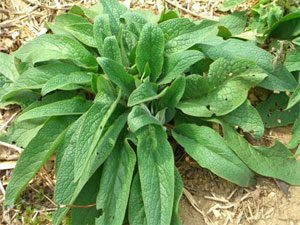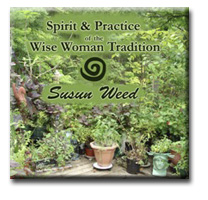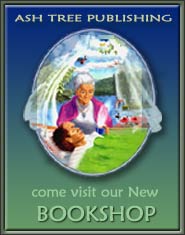Comfrey: Learning to Love Her
by Corinna Wood
Director of Red Moon Herbs
When I first met her, we were on no uncertain terms: comfrey was not my friend.
 I was in college, my first year, and one thing I was determined to have was a garden. This was The Evergreen State College, in Washington State, the dawn of my granola years. I biked down to the community garden and found my personal plot. It was buried in a sea of comfrey.
I was in college, my first year, and one thing I was determined to have was a garden. This was The Evergreen State College, in Washington State, the dawn of my granola years. I biked down to the community garden and found my personal plot. It was buried in a sea of comfrey.
I didn't know what comfrey was at the time. All I knew was that it wasn't corn, and was not tomatoes. And it was in the way. But whatever I tried to pull out simply broke off. I finally sat back to wipe the sweat off, and looked around. This weed was all over the garden!
The garden coordinator laughed. "Careful where you toss that stuff," she said. "You're looking at a new patch of comfrey wherever it hits the ground." It turned out that someone a few years ago had the bright idea of tilling through the comfrey patch, and then proceeded on to till through the rest of the garden. Within three seasons, comfrey had sprung up across the entire acre.
Like a mythical monster, the smallest bit of comfrey root can sprout a whole new plant. It's the plant that keeps on giving. You can chop comfrey to the ground and it will come back, enough to be harvested three or four times a year. But excuse me, did I say harvest?
They say if you can't beat 'em, join 'em, and it was in trying to get rid of comfrey that I learned to appreciate it. Comfrey's Latin name is Symphytum officinale, and symphytum actually means to join or unite--in essence, to heal. Whether it's cuts, burns, scars, wrinkles, or even broken bones (comfrey is aka "knitbone"), the same properties that enable comfrey to regrow a whole new plant from a bit of root can also help the body heal from some of the most devastating injuries. Internally, comfrey also supports the respiratory, digestive, and urinary systems.
During my college years, a family living nearby befriended me, and they helped me come to appreciate comfrey. I was especially impressed the time I witnessed the dad, Todd, using comfrey to speed the healing when he broke his foot.
His doctor put Todd's foot in a removable cast and told him to come back in six weeks to check on how the healing was progressing.
For years, their whole family had been drinking herbal infusions--strong, medicinal teas.  Comfrey had been an old favorites for coughs, but this was their first opportunity to try it out for broken bones.
Comfrey had been an old favorites for coughs, but this was their first opportunity to try it out for broken bones.
That night, Todd put a cup of the dried leaf in a quart-size canning jar, filled the jar with boiling water, and put a lid on it. In the morning, he strained out the plant material and packed it on his foot as a poultice. He drank the liquid over the day, either reheated or at room temperature, sometimes sweetened with honey.
Todd did this every day for two weeks, and he was amazed how quickly the pain and swelling decreased. In fact, he called in to see the doctor a month early. After a prolonged argument with the receptionist, he finally managed to get an appointment the following week. When the doctor took new x-rays, he was amazed to discover that the bone had fully mended. He said he had never before seen such a quick recovery. Rather than credit it to comfrey, the doctor insisted that it could only be called a miracle.
In Europe, for generations, comfrey was one of the plants that almost everyone kept right outside their doorstep, and this revered medicine plant followed us to the new world. More of a domesticated plant than a weed, comfrey has been long been an essential part of the traditional herbal medicine chest to treat a wide array of ailments.
That's how it earned the other part of its name, officinale. Until recently, comfrey was an official medicine, one of a handful of the most respected medicine plants that merited "officinale" in their Latin names. Those fond of manicured lawns might recognize another member of the royal dispensary, dandelion (Taraxicum officinale).
Today, most doctors don't just discount comfrey, they warn against using it. Comfrey has been declared unsafe by the FDA for internal use. If comfrey has been used for centuries, why is it now considered toxic and too dangerous to be used medicinally?
The FDA's declaration was based on a study in which the pyrrolizidine alkaloids were extracted from the roots of comfrey and injected in large doses into rats. Researchers found that this caused pre-cancerous liver changes in the rats, which somehow became translated as "comfrey causes cancer."
Now, injecting oneself with a drug made in a lab from the roots is very different than drinking a cup of tea. Many herbalists have called this study into question for several reasons: (1) It makes a big difference when one compound is isolated from the rest of the constituents that make up the chemistry and magic of the plant. (2) One would have to drink dozens if not hundreds of cups of comfrey to consume the amount of alkaloids each rat was given. (3) Humans and rats don't necessarily respond to alkaloids the same way, and there have been no clinical studies done with humans.
In fact, as herbalists Mary L. Wulff-Tilford and Gregory L. Tilford state, "In thousands of years of use by millions of people, only two reports of hepatotoxicity (liver cell toxicity) have been documented in humans." And in both these cases, poor nutrition, pre-existing illness, and use of liver-toxic drugs were contributing factors.
Nevertheless, this article focuses primarily on using comfrey externally. Of course, the safety issues only apply to taking comfrey internally; for many ailments comfrey can be used externally instead. In addition, the leaves, which have much lower concentrations of these alkaloids, can be used instead of the roots.
One way to get the benefits of comfrey for external use is by making comfrey oil (see sidebar, below). This oil and the salve made from it (by melting in beeswax for a firmer consistency), is soothing and moisturizing. Comfrey oil and salve are used for people with dry skin, chapped lips, excema, cuts, scrapes, and burns (in the later stages, after the initial hot sensation has subsided). I use comfrey salve every time after I bathe--as a moisturizer, it nourishes the skin and prevents wrinkles.
Making your own Comfrey Oil
1. Harvest the comfrey leaves in the afternoon, after the sun has dried off the morning dew. Wet plant materials will make moldy oils, so it is best to wait at least 36 hours after the last rain before harvesting.
2. In a warm, dry, well-ventilated place (such as an attic, an oven with a pilot light, or even your car!), wilt the whole fresh leaves for 12 hours or until the edges are crispy.
3. Stuff your jar completely full of the whole wilted leaves, leaving a little headroom. Add olive oil until the jar is full to the brim.
4. Tightly seal the jar. Label it with the plant name and date harvested. Put it in a dish on the counter (herbal oils always leak).
5. Tend it a few times a week by poking the plant material down to release air bubbles and topping it off so the level of the oil is above the level of the leaves.
6. After six weeks, strain out the plant material, and your infused oil is ready to use!
I got a call a few weeks ago from an elderly woman who was suffering so badly from eczema that the skin on her hands was cracking open. She had used a variety of creams and lotions that doctors had prescribed over the years, all to no avail. After using comfrey salve for just two days, not only was the pain gone, but also the skin had actually closed over her knuckles.
Comfrey is so effective as a wound-healer that one actually has to be careful using it. If only the tissues close to the surface are in contact with the comfrey, it can actually cause the skin to close over, trapping infection inside. For deep wounds, a plant such as Plantain (Plantago lanceolata or P. major) would be more appropriate (see Corinna's "Plantain: First Aid in Your Backyard" article).
Comfrey also has specific uses for women, and many of my women friends swear by it. During pregnancy, comfrey oil is a favorite for belly massage, promoting elasticity and preventing stretch marks. Many new moms rely on comfrey salve for diaper rash and for quick relief and speedy healing from sore and cracked nipples (apply after breastfeeding, and wipe the area gently before the next feeding). And comfrey oil makes an excellent vaginal lubricant, helping both to moisturize and strengthen the vaginal tissues without any added fragrances or preservatives. However, oil degrades condoms, so with condoms only water-based lubricants should be used.
Over the years, as I came to appreciate comfrey's many virtues, I asked her to be my friend after all. Now comfrey is one of my favorites that I keep in the kitchen garden close at hand. Comfrey doesn't ask for much special attention--this prolific plant will grow almost anywhere, but it is happiest in rich, moist soil in full sun to partial shade. And it will behave itself if left alone--as long as the roots are left undisturbed, comfrey will stay in its place.

 Corinna Wood is the director of Red Moon Herbs, making herbal medicines from fresh, local plants, with a focus on women's health, for over ten years. A gifted teacher and powerful visionary, Corinna has opened the hearts of thousands to the wisdom of the plants and their own bodies. Corinna's background includes an extensive apprenticeship with Susun Weed in 1993 as well as a B.S. in Biology. Corinna is certified as an herbalist, a fertility awareness teacher, and also in permaculture design.
Corinna Wood is the director of Red Moon Herbs, making herbal medicines from fresh, local plants, with a focus on women's health, for over ten years. A gifted teacher and powerful visionary, Corinna has opened the hearts of thousands to the wisdom of the plants and their own bodies. Corinna's background includes an extensive apprenticeship with Susun Weed in 1993 as well as a B.S. in Biology. Corinna is certified as an herbalist, a fertility awareness teacher, and also in permaculture design.
You are invited to attend Corinna's classes - see Classes Overview page for current opportunities to study with Corinna.
Red Moon Herbs offers Comfrey Salve and Dried Comfrey.



 Corinna Wood is the director of
Corinna Wood is the director of 
 CORRESPONDENCE COURSES
CORRESPONDENCE COURSES 

